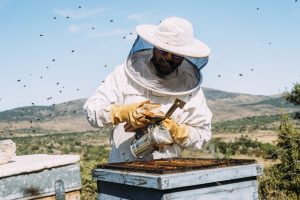If you’re thinking about starting a beekeeping hobby or maybe even a business, it’s essential to understand that honey isn’t the only thing bees can provide. While honey will be your bread and butter, you can maximize your profits by making full use of your bees.
Bee Pollen
As bees go about gathering nectar, pollen will unavoidably stick to their little bodies. While pollen is a natural part of their diet, they usually bring in more pollen than they can eat. Some beekeepers will use a system of holes and tubes, but you can readily buy pre-made pollen traps in stores that deal in beekeeping equipment. Bee pollen is readily marketable. Some treat it as a superfood, and even Germany’s Federal Ministry of Health considers it a form of medicine. Even your fellow beekeepers might want some of your pollen. Larger colonies might have trouble foraging for food, and beekeepers sometimes need to acquire additional pollen.
Beeswax
An ounce of beeswax can quickly sell for a dollar or more. You’ll naturally get a few pounds of beeswax every time you harvest honey. Don’t use the honeycombs for beeswax! Bees will need to use up 6 pounds of honey to rebuild a pound’s worth of combs, so take the excess beeswax when harvesting honey. While the amount of beeswax may be small (you’ll typically get 2 lbs for every 100 lbs of honey), selling your beeswax in carefully designed packaging also serves as a form of advertising for your honey. Organic beeswax is used in cooking, lip balms, moisturizers, pain relief ointments, and candles.
Bees for Hire

Pollinating is what bees do best, and many agricultural producers need these services. Bees aren’t as numerous as before, and beekeepers are one of the reasons their number haven’t wholly plummeted. This lack of bees can sometimes force farms to hire the services of kept bees. A typical pollination contract requires you to move a hive or two and stay in a designated location for two to three weeks — enough time for your bees to do their work. Almond and blueberry farms are some of the leading contractors for pollination services followed by flower farms and fruit farms.
Raising Queens
A typical queen bee can cost $20-$25, so just raising a few of them can pay for the cost of your hive setup. You can raise queens naturally by splitting hives, but grafting is a surer way to get those queens. Grafting requires a little bit of precision and meticulous work, but even a beginner can succeed after a few attempts. You’ll need to select larva that can grow into a queen, place it in a tiny container, and put it in a queenless hive. Nursing bees will feed and care for that larva, making sure it grows into a queen. You can sell the queen, build another colony, or keep it for a rainy day.
Getting sweet, creamy honey is great, but make sure to maximize the earning potential of your bees by exploring every single way to make money.

